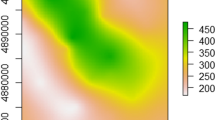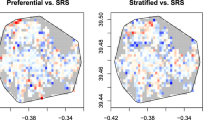Abstract
In this study a conceptual framework for assessing the statistical properties of a non-stochastic spatial interpolator is developed through the use of design-based finite population inference tools. By considering the observed locations as the result of a probabilistic sampling design, we propose a standardized weighted predictor for spatial data starting from a deterministic interpolator that usually does not provide uncertainty measures. The information regarding the coordinates of the spatial locations is known at the population level and is directly used in constructing the weighting system. Our procedure captures the spatial pattern by means of the Euclidean distances between locations, which are fixed and do not require any further assessment after the sample has been drawn. The predictor for any individual value turns in a ratio of design-based random quantities. We illustrate the predictor design-based statistical properties, i.e. asymptotically p-unbiasedness and p-consistency, for simple random sampling without replacement. An application to a couple of environmental datasets is presented, for assessing predictor performances in correspondence of different population characteristics. A comparison with the equivalent non-spatial predictor is presented.
Similar content being viewed by others
References
Baffetta F, Fattorini L, Franceschi S, Corona P (2009) Design-based approach to k-nearest neighbours technique for coupling field and remotely sensed data in forest surveys. Remote Sens Environ 113: 463–475
Bao Y, Ullah A (2010) Expectation of quadratic forms in normal and nonnormal variables with applications. J Stat Plan Infer 140: 1193–1205
Bolfarine H, Zacks S (1992) Prediction theory for finite populations. Springer, New York
Brus DJ, de Gruijter JJ (1997) Random sampling or geostatistical modelling? Choosing between design-based and model-based sampling strategies for soil (with discussion). Geoderma 80: 1–44
Cicchitelli G, Montanari GE (2012) Model-assisted estimation of a spatial population mean. Int Stat Rev 80: 111–126
Cocchi D, Mouchart M (1996) Quasi-linear bayes estimation in stratified finite populations. J Roy Stat Soc B 58: 293–300
Cressie NAC (1993) Statistics for spatial data. Wiley, New York
Diggle PJ, Ribeiro PJ Jr. (2007) Model-based geostatistics. Springer, New York
Dol W, Steerneman T, Wansbeek T (1996) Matrix algebra and sampling theory: the case of the Horvitz–Thompson estimator. Linear Algebra Appl 237: 225–238
Fattorini L (2006) Applying the Horvitz–Thompson criterion in complex designs: a computer-intensive perspective for estimating inclusion probabilities. Biometrika 93: 269–278
Gaetan C, Guyon X (2010) Spatial statistics and modeling. Modélisation et statistique spatiales. Springer, New York
Ghosh S, Gelfand AE, Mølhave T (2012) Attaching uncertainty to deterministic spatial interpolations. Stat Methodol 9: 251–264
Gregoire TG (1998) Design-based and model-based inference in survey sampling: appreciating the difference. Can J Forest Res 28: 1429–1447
Herzel A (1986) Sampling without replacement with unequal probabilities: sample designs with preassigned joint inclusion probabilities of any order. Metron 44: 49–68
Magnus JR, Neudecker H (2007) Matrix differential calculus with application in statistics and econometrics. Wiley, New York
Royall RM, Pfeffermann D (1982) Balanced samples and robust Bayesian inference in finite population sampling. Biometrika 69: 401–409
Särndal C-E, Swensson B, Wretman J (1992) Model assisted survey sampling. Springer, New York
Shepard D (1968) A two-dimensional interpolation function for irregularly-spaced data. In: Proceedings of the 1968 23rd association for computing machinery national conference, pp 517–523
Stuart A, Ord K (1987) Kendall’s advanced theory of statistics, distribution theory, vol 1. Oxford University Press, New York
Tobler WR (1970) A computer movie simulating urban growth in the Detroit region. Econ Geogr 46: 234–240
Ver Hoef J (2002) Sampling and geostatistics for spatial data. Ecoscience 9: 152–161
Webster R, Oliver MA (2007) Geostatistics for environmental scientists. Wiley, Chichester
Author information
Authors and Affiliations
Corresponding author
Additional information
Handling Editor: Pierre Dutilleul.
Work supported by the project PRIN 2008, New developments in sampling theory and practice, Project number 2008CEFF37, sector: Economics and Statistics, awarded by the Italian Government.
Rights and permissions
About this article
Cite this article
Bruno, F., Cocchi, D. & Vagheggini, A. Finite population properties of individual predictors based on spatial patterns. Environ Ecol Stat 20, 467–494 (2013). https://doi.org/10.1007/s10651-012-0229-9
Received:
Revised:
Published:
Issue Date:
DOI: https://doi.org/10.1007/s10651-012-0229-9




